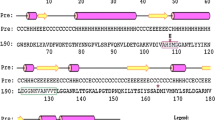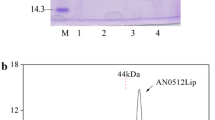Abstract
An organic solvent-tolerant lipase from Serratia marcescens ECU1010 (rSML) was overproduced in Escherichia coli in an insoluble form. High concentrations of both biomass (50 g cell wet weight/L culture broth) and inclusion bodies (10.5 g/L) were obtained by applying a high-cell-density cultivation procedure. Activity assays indicated that the enzymatic activity of rSML reached 600 U/L. After treatment with isopropyl ether for 12 h, the maximum lipase activity reached 6,000 U/L. Scanning electron microscopy and Fourier transform infrared microspectroscopy revealed the activation mechanism of rSML in the presence of organic solvents. rSML was stable in broad ranges of temperatures and pH values, as well as in a series of organic solvents. Besides, rSML showed the best enantioselectivity for the kinetic resolution of (±)-trans-3-(4-methoxyphenyl)glycidic acid methyl ester. These features render the S. marcescens ECU1010 lipase attractive for biotechnological applications in the field of organic synthesis and pharmaceutical industry.





Similar content being viewed by others
Abbreviations
- DMSO:
-
Dimethyl sulfoxide
- ee :
-
Enantiomeric excess
- FT-IR microspectroscopy:
-
Fourier transform infrared microspectroscopy
- KPB:
-
Potassium phosphate buffer
- (±)-MPGM:
-
(±)-trans-3-(4-methoxyphenyl)glycidic acid methyl ester
- (−)-MPGM:
-
(2R,3S)-3-(4-methoxyphenyl)glycidic acid methyl ester
- pNPA:
-
p-Nitrophenyl acetate
- SEM:
-
Scanning electron microscopy
- vvm:
-
Volume of air per volume of media per minute
References
Keasling, J. D. (2008). Synthetic biology for synthetic chemistry. ACS Chemical Biology, 3, 64–76.
Jong, H.C., Ki, C.K., Sang, Y.L. (2006) Production of recombinant proteins by high cell density culture of Escherichia coli. Chemical Engineering Science, 61, 876–885.
Ami, D., Natalello, A., Taylor, G., Tonon, G., & Doglia, S. M. (2006). Structural analysis of protein inclusion bodies by Fourier transform infrared microspectroscopy. Biochimica et Biophysica Acta, 1764, 793–799.
Gonzalez-Montalban, N., García-Fruitós, E., Ventura, S., Aris, A., & Villaverde, A. (2006). The chaperone DnaK controls the fractioning of functional protein between soluble and insoluble cell fractions in inclusion body-forming cells. Microbial Cell Factories, 5, 26.
Arie, J. P., Miot, M., Sassoon, N., & Betton, J. M. (2006). Formation of active inclusion bodies in the periplasm of Escherichia coli. Molecular Microbiology, 62, 427–437.
García-Fruitós, E., González-Montalbán, N., Morell, M., Vera, A., Ferraz, R. M., Arís, A., et al. (2005). Aggregation as bacterial inclusion bodies does not imply inactivation of enzymes and fluorescent proteins. Microbial Cell Factories, 4, 27.
Indu, B., Rajinder, P., Gulam, N. Q., et al. (2008). Lipase enzyme immobilization on synthetic beaded macroporous copolymers for kinetic resolution of chiral drugs intermediates. Process Biochemistry, 43, 321–330.
Gandhi, N. N. (1997). Applications of lipase. Journal of the American Oil Chemists' Society, 74, 621–634.
Ribeiro, C. M. R., Passaroto, E. N., & Brenelli, E. C. S. (2001). Enzymatic resolution of ethyl 3-hydroxy-3-phenylpropanoate and analogs using hydrolases. Journal of the Brazilian Chemical Society, 12, 742–746.
Frings, K., Koch, M., & Hartmeier, W. (1999). Kinetic resolution of 1-phenyl ethanol with high enantioselectivity with native and immobilized lipase in organic solvents. Enzyme and Microbial Technology, 25, 303–309.
Ying-Yang, J., Martin, S., & Hans-Ulrich, B. (2002). The enantioselective hydrogenation of 1-phenyl ethanol and of ketones using Pt and Pd supported on natural polymers. Journal of Molecular Catalysis A: Chemical, 177, 307–308.
Singh, S., & Banerjee, U. C. (2007). Purification and characterization of trans-3-(4-methoxyphenyl) glycidic acid methyl ester hydrolyzing lipase from Pseudomonas aeruginosa. Process Biochemistry, 42, 1063–1068.
Nagao, T., Sato, M., Nakajima, H., & Kiyomoto, A. (1972). Studies on a new 1,5-benzothiazapine derivative (CRD-401). II. Vasodilator actions. Japanese Journal of Pharmacology, 22, 1–10.
Hulshof, L.A., Roskan, J.H. (1989) Phenylglycidate stereoisomers, conversion products thereof with e.g. 2-nitrothiophenol and preparation of diltiazem. European Patent Application 343714.
Matsumae, H., Furui, M., & Shibatani, T. (1993). Lipase-catalyzed asymmetric hydrolysis of 3-phenylglycidic acid ester, the key intermediate in synthesis of Diltiazem hydrochloride. Journal of Fermentation and Bioengineering, 75, 93–98.
Long, Z. D., Xu, J. H., Zhao, L. L., Pan, J., Yang, S., & Hua, L. (2007). Overexpression of Serratia marcescens lipase in Escherichia coli for efficient bioresolution of racemic ketoprofen. Journal of Molecular Catalysis B: Enzymatic, 47, 105–110.
Gao, L., Xu, J. H., & Li, X. J. (2004). Optimization of Serratia marcescens lipase production for enantioselective hydrolysis of 3-phenyl glycidic acid ester. Journal Industry Microbiology Biotechnology, 31, 525–530.
Chin, J. H., Rahman, R. N. Z. A., Salleh, A. B., & Basri, M. (2003). A newly isolated organic solvent-tolerant Bacillus sphaericus 205y producing organic solvent-stable lipase. Biochemical Engineering Journal, 15, 147–151.
Diletta, A., Antonino, N., Pietro, G. L., Marina, L., & Silvia, M. D. (2005). Kinetics of inclusion body formation studied in intact cells by FT-IR spectroscopy. FEBS Letters, 579, 3433–3436.
Lee, S. Y. (1996). High cell-density culture of Escherichia coli. Trends in Biotechnology, 14, 98–105.
Seo, D. J., Chung, B. H., Hwang, Y. B., & Park, Y. H. (1992). Glucose-limited fed-batch culture of Escherichia coli for production of recombinant human interleukin-2 with the DO-Stat method. Journal of Fermentation and Bioengineering, 74, 196–198.
Gupta, R., Gupta, N., & Rathi, P. (2004). Bacterial lipases: An overview of production, purification and biochemical properties. Applied Microbiology and Biotechnology, 64, 763–781.
Yuzo, K., Michihiko, K., & Sakayu, S. (2003). A novel lipase from Pseudomonas fluorescens HU380: Gene cloning, overproduction, renaturation-activation, two-step purification, and characterization. Journal of Bioscience and Bioengineering, 96, 242–249.
Zhang, A. J., Gao, R. J., Diao, N. B., Xie, G. Q., et al. (2009). Cloning, expression and characterization of an organic solvent tolerant lipase from Pseudomonas fluorescens JCM5963. Journal of Molecular Catalysis B: Enzymatic, 56, 78–84.
Akatsuka, H., Kawai, E., Omori, K., Komatsubara, S., Shibatani, T., & Tosa, T. (1994). The lipA gene of Serratia marcescens which encodes an extracellular lipase having no N-terminal signal peptide. Journal of Bacteriology, 176, 1949–1956.
Amada, K., Haruki, M., Imanaka, T., Morikawa, M., & Kanaya, S. (2000). Overproduction in Escherichia coli, purification and characterization of a family I.3 lipase from Pseudomonas sp. MIS38. Biochimica et Biophysica Acta, 1478, 201–210.
Rollof, J., Hedstrom, S. A., & Nilsson-Ehle, P. (1987). Positional specificity and substrate preference of purified Staphylococcus aureus lipase. Biochimica et Biophysica Acta, 921, 370–377.
Zhao, L. L., Xu, J. H., Zhao, J., Pan, J., & Wang, Z. L. (2008). Biochemical properties and potential applications of an organic solvent tolerant lipase isolated from Serratia marcescens ECU1010. Process Biochemistry, 43, 626–633.
Shibatani, T., Matsumae, H., Akatsuka, H. (1991) Esterase from Serratia and process for preparing the same. European Patent Application 446771.
Salamone, P. R., & Wodzinski, R. J. (1997). Production, purification and characterization of a 50-kDa extracellular metalloprotease from Serratia marcescens. Applied Microbiology and Biotechnology, 48, 317–324.
Li, S. X., Pang, H. Y., Lin, K., Xu, J. H., et al. (2011). Refolding, purification and characterization of an organic solvent-tolerant lipase from Serratia marcescens ECU1010. Journal of Molecular Catalysis B: Enzymatic, 71, 171–176.
Henley, J. P., & Sadana, A. (1985). Categorization of enzyme deactivations using a series-type mechanism. Enzyme and Microbial Technology, 7, 50–60.
Kojima, Y., Yokoe, M., & Mase, T. (1994). Purification and characterization of an alkaline lipase from Pseudomonas fluorescens AK102. Bioscience, Biotechnology, and Biochemistry, 58, 1564–1568.
Matsumae, H., & Shibatani, T. (1994). Purification and characterization of the lipase from Serratia marcescens Sr41 8000 responsible for asymmetric hydrolysis of 3-phenylglycidic acid esters. Journal of Bioscience and Bioengineering, 77, 152–158.
Schmidt-Dannert, C., Sztajer, H., Stocklein, W., Menge, U., & Schmid, R. D. (1994). Screening, purification and properties of a thermophilic lipase from Bacillus thermocatenulatus. Biochimica et Biophysica Acta, 1214, 43–53.
Klibanov, A. M. (1997). Why are enzymes less active in organic solvents than in water?. Trends in Biotechnology, 15, 97–101.
Zaks, A., & Klibanov, A. M. (1988). Enzymatic catalysis in nonaqueous solvents. Journal of Biological Chemistry, 263, 3194–3201.
Carrió, M. M., Corchero, J. L., & Villaverde, A. (1998). Dynamics of in vivo protein aggregation: building inclusion bodies in recombinant bacteria. FEMS Microbiology Letters, 169, 9–15.
Przybycien, T. M., Dunn, J. P., Valax, P., & Georgiou, G. (1994). Secondary structure characterization of beta-lactamase inclusion bodies. Protein Engineering, 7, 131–136.
Acknowledgments
This work was financially supported by the National Natural Science Foundation of China (no. 20506037) and the Open Funding Project of the State Key Laboratory of Bioreactor Engineering.
Author information
Authors and Affiliations
Corresponding author
Rights and permissions
About this article
Cite this article
Li, S., Lin, K., Pang, H. et al. Production, Characterization, and Application of an Organic Solvent-Tolerant Lipase Present in Active Inclusion Bodies. Appl Biochem Biotechnol 169, 612–623 (2013). https://doi.org/10.1007/s12010-012-0028-7
Received:
Accepted:
Published:
Issue Date:
DOI: https://doi.org/10.1007/s12010-012-0028-7




